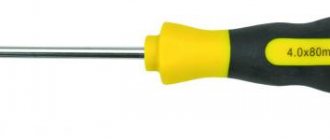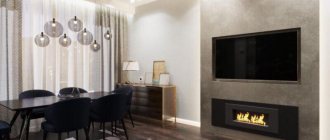02/15/2019Repair0
Effective lighting of a living space plays an important role for comfortable living and work. The level of light affects the degree of fatigue and the emotional state in general. That is why it is important to be able to calculate lighting according to the area of the room; it is also important to choose the right chandelier or lamp that can give the room its own special touch, or support the overall existing composition.
- 1 Choosing a chandelier size
- 2 Formula for calculating the diameter of a chandelier based on the area of the room
Types of chandeliers
There are several types of chandeliers depending on the type of mounting, glow power and style.
- Ceiling. They are attached through the base of the structure or on a special strip in the case of a suspended ceiling. The devices are called overhead and are well suited for low ceilings up to 2.5 m. These, for example, are available in several series of the German brand Schaffner, whose products are widely represented in Moscow.
- Hanging. Metal chains are attached to their base, and then the structure itself. This is also a suitable option for rooms with ceilings no more than 2.5 m.
- Wall-mounted. Models are installed on the wall and are most often called sconces. The store's catalog contains many lamps in the Art Nouveau style from the Favor, Lavero, Forro and other collections from Schaffner. These are pendant or bracket models, with a flat shade, open or closed bowl.
- LED. The last word in design and technology. Inside there are many LEDs, a semiconductor crystal and an optical system. The advantage of the design is that it consumes less electricity than chandeliers with conventional incandescent lamps. Moreover, the service life of such a model is 50 thousand hours, which is about 10 years of operation. It is represented by the Escudo, Castillo, Escudo and others series from the Schaffner brand.
Choosing lamps for the bedroom
In this room, people usually rest from the fatigue accumulated during the day. Therefore, it is preferable to buy a lamp for the bedroom in soothing colors, but it is also necessary to take into account the key design of the room. Currently, it is considered very popular to install large pendant chandeliers in a classical style or, conversely, ordinary ascetic lamps in the Japanese style. To install a pendant lamp, you need a high ceiling, otherwise you will have to limit yourself to installing small ceiling chandeliers, reinforced with spotlights distributed around the perimeter of the room. LED lighting is also considered very popular.
It is a well-known fact that one chandelier cannot create a cozy atmosphere; designers always choose additional bedside sconces in an identical style (this should be taken care of at the stage of forming the design of the room in order to install the wiring), or interior table lamps.
How to calculate the size of a chandelier?
To calculate the required size, a special formula has been invented: width of the room (in meters) + length of the room (in meters) × 10 = suitable diameter of the lighting fixture (in centimeters).
For example, a room is 3 meters wide and 5 meters long. Then we find that a chandelier with a diameter of 80 cm will fit perfectly into the room.
But this is just one of the mathematical formulas that may not always fit real conditions. To make sure it is correct or, conversely, to look for a model of a different size, there is another formula. According to it, you need to add the width and length of the room, and then divide the resulting amount by 0.14. If we consider it using the same room as an example, it turns out that a smaller chandelier is needed - with a diameter of 57 cm.
Dining room
Hanging height: the lower level of the chandelier should be 75-92 cm above the table surface. Where to hang: Mount the light above the middle of the table, not in the middle of the room. Chances are your kitchen will have furniture along the walls and your dining table will most likely be located off center of the room, so a chandelier hanging in the middle of the space would be out of place.
Above the kitchen island
Hanging height: the lower part of the chandelier should hang no lower than 75-92 cm above the tabletop. Where to hang: Center the chandelier in the center of the island. However, if you are hanging multiple pendant lights or mini chandeliers, we recommend placing the lights 70-75cm apart across the width of the island's centerline. If you have three lamps, place one taller in the center, and then hang the other two 75cm on either side of the central lamp.
Choosing a chandelier depending on the ceiling height
When choosing a chandelier, it is important to remember the height of the ceiling. There is another formula for this: divide the distance from floor to ceiling by 6. For example, the height of the room is 2.5 meters. Dividing this value by 6, we get 0.41 m or 41 cm. This should be the approximate height of the lighting fixture.
For rooms with higher ceilings, you should give preference to large chandeliers in order to evenly illuminate the entire area. If the room has the shape of a rectangle, then it would be logical to mount two small appliances or complement them with several laconic sconces.
For low ceilings, a ceiling lamp with a large beam angle and minimal height is suitable. A good option is the “saucer” shape.
Hallway, bedroom or living room
Hanging height: To avoid hitting anyone's head, there should always be at least 215 cm of clearance between the lower level of the chandelier and the floor. However, if your ceiling is higher than 250 cm, then you should hang the chandelier higher. If you have a two-story foyer, the bottom of the light fixture should hang at the same level as the second floor. Where to hang it: If you have a large foyer, a chandelier placed above a round table is quite a good solution. In a small hallway, the chandelier should hang in the middle of the room.
If you intend to place the chandelier in your bedroom or living room, place it in the middle of the room or above the bed (or above the coffee table). Mini chandeliers also look great when hung above nightstands, but remember the rule: 75-92 cm!
Power and types of lamps
The total power for a particular room is calculated using the formula: area × recommended power indicator. If the ceiling height is more than 3 m, then the result obtained is multiplied by at least 1.5, since high ceilings “eat up” a considerable amount of light.
If the power is determined, then the type of lamps can be selected. Each of them has its own advantages and disadvantages, so it is worth buying taking into account the operating conditions.
Incandescent lamps are low cost but have minimal energy efficiency. If the power is calculated incorrectly, the chandelier may melt or crack.
LED lamps are very economical and have a long service life. Among the disadvantages is that if the power and temperature of the light are chosen incorrectly, the light fluxes can be uncomfortable for vision. LEDs are also more expensive than other types.
Halogen lamps last a long time and provide powerful lighting. However, sometimes, especially in small rooms, it can be too bright and unpleasant to the eye.
Fluorescent lamps have good power and efficiency and last a long time. But due to the evenness and coldness of the light, the eyes can become tired. Also, the cost of lamps is quite high.
Which lamps are the brightest?
LEDs are the brightest lighting sources. For example, the luminous flux of a 4-8 W LED bulb corresponds to the flux of a 40 W or 60 W incandescent lamp.
Interesting materials:
How to clean foam rubber? How to clean stone coated cookware? How to clean a down jacket? How to clean down pillows? How to clean a vacuum cleaner with a cyclone filter? How to clean a sink with caustic soda? How to clean elastic in the washing machine? How to clean the gray row? How to clean jacket sleeves? How to clean saffron milk caps?
Calculation of lighting for a room
The degree of illumination is initially influenced by the number of horns, the power of the light bulbs and their type. You also need to consider what room the chandelier is intended for. For example, the living room needs brighter lighting, while the bedroom needs dim lighting.
When choosing, you should be guided by the following power ranges:
- Bathroom from 4 to 6 squares - 80–100 W;
- Kitchen from 7 to 10 square meters - 120–150 W;
- Living room about 15 square meters - 200–300 W;
- Bedroom from 6 to 9 square meters - 100 W.
Main conclusions
When buying a chandelier, you need to be guided not only by your own idea of beauty. But we must take into account:
- ceiling height and room dimensions;
- where to buy a chandelier - in the bedroom, kitchen, nursery, hallway.
- interior style;
- type of ceilings.
It is also important to consider what material the lamp is made of and whether the power of the light bulbs matches the capabilities of the chandelier. The lamp should not only be beautiful, but also safe.
Previous
ChandeliersWhat to do if the chandelier does not turn on from the remote control
Next
Chandeliers5 ideas on how to make a chandelier for a children's room
Materials for chandeliers - which is better?
The degree of illumination is also influenced by the shape of the chandelier and the material from which the lampshades are made. If the horns of the lighting fixture point upward, then there may not be enough light in the room. This often happens when using sconces. Lampshades made of dark glass or colored plastic dim the brightness of light fluxes.
Glass and crystal models transmit light well, look elegant and are most often used in a classic style. Metal chandeliers usually decorate rooms in loft, modern, and high-tech styles. Textile models fit well into boho, ethnic and classic styles. They are best equipped with LED lamps.
Design ideas
To zone the living room, you can hang two ceiling chandeliers and thereby highlight each functional area. Installing multiple lighting fixtures is more suitable for spacious rooms.
The fireplace in the hall can influence the choice of light source. For example, in combination with a classic portal, a forged product with candles, stylized as a candelabra, will look advantageous.
An original solution is to decorate a chandelier using a mirror. A mirror panel installed at the base of the product will interestingly reflect and increase the light in the living room.
Stylish chandeliers on a rod look no less impressive. Thanks to this additional element, convenient height adjustment of the structure is provided. If you lower the lamp, you will be able to highlight and highlight a certain object in the room; when raised, the lamp will allow you to achieve comfortable diffused lighting in the room.
Models with stained glass shades, which are made using multi-colored pieces of glass, also deserve special attention.
The photo shows three chandeliers on the ceiling in the interior of a large hall.
Unusual chandeliers in the shape of a sphere woven from branches and other designer lamps with natural symbolism are popular. For example, the design uses a frame base covered with butterflies, or the product itself is made in the shape of an octopus, jellyfish and other inhabitants of the animal world.
Chandelier and interior style
For a classic style, elegant crystal chandeliers, as well as glass or metal models, are suitable. Options with fabric lampshades are also possible.
Chandeliers with chrome elements and frosted or glossy glass inserts will help make the modern style more characteristic and elegant. Both LED and products with clear geometric patterns look original.
Modernism will be made more interesting by LED lights, as well as chandeliers made of colored glass or with plastic parts. Devices with a metal frame, as well as hanging options, fit well into the loft.
The number of lamps in a chandelier for the hall
A bright chandelier is suitable for the hall, which will illuminate the space well. For incandescent lamps, you can use the formula 20 watts per 1 square meter. For LED lamps, the formula is 200 lumens per 1 sq.m. Let's first calculate in watts.
Hall 16 sq.m. and incandescent lamps: 16 * 20 W = 320 W. Now let's divide 320 by 60 W (the rating of the lamps that you use in the chandelier). 320 / 60 = 5.3. That is, for a hall of 16 sq.m. you need 5-6 lamps of 60 watts.
Now let's count in lumens. Hall 16 sq.m. and LED lamps: 16 * 200 Lm = 3200 Lm. The entire hall will require 3200 Lm. If we take LED lamps of 600 lm, then we need 3200/600 = 5.3. That is, 5-6 lamps per room of 16 sq.m.
Hall 18 sq.m. (18*200) / 600 = 6 lamps of 600 lumens.
Hall 18 square meters: chandelier, sconces and lamps. There is never too much light.
Hall 20 sq.m. (20*200) / 600 = 6.6. Those. 6-7 lamps of 600 lumens.
Calculations are approximate, because The level of illumination in the hall depends on the color of the walls and floor, whether your ceiling is white or not, and what type of chandelier is used. Chandeliers with open candle lamps, crystal chandeliers and lamps with translucent glass shades shine brightly. Chandeliers with dense textile lampshades and metal shades dimly illuminate the rooms.
Lamps in a studio apartment 26 square meters, bedroom 15 square meters.
Do not use high-power lamps if this is not provided for by the design of the lamp. The maximum power is indicated in the instructions for the lamp. There may be a sticker on the cartridge. The maximum permissible number of watts is indicated on our website. These restrictions apply to incandescent lamps, because... they get very hot and can damage the lamp. If the number of watts is exceeded, the cartridge may melt, the textile lampshade may be deformed, and the wiring in the lamp may burn out. To avoid this, read on.
Chandeliers for suspended ceilings
Since the material of suspended ceilings reacts to increased temperature (at 80 degrees the coating changes color), it is important to consider several rules when choosing and installing a chandelier on suspended ceilings:
- The horns should be down or pointing to the side. The distance to the ceiling should be at least 20 cm.
- It is worth abandoning a complex fastening system that can damage the ceiling.
- If the ceiling is glossy, then lamps with diffused light that will not reflect the ceiling are desirable.
- It is advisable to hide power converters for LED and halogen lamps in niches, where they will be easier to repair if necessary.
- If you need to install chandeliers with horns looking up, or models without shades and reflectors, it is worth purchasing LED and energy-saving light bulbs. The distance to the ceiling in this case can be from 40 cm.
- The power of halogen lamps should be minimal (35 W), because they heat up almost immediately.
Mistake #4: outdated, ridiculous, unfashionable chandelier model
So I’ve come to the most common and most interesting, but most difficult to explain from a decorator’s point of view, mistake. Someone might argue that appearance is of secondary importance, because I myself said that the main thing in lighting is function. But if you neglect it, then all your efforts to make your home beautiful will come to naught.
I noticed that light is the jewelry of the house. And it has its own fashion, which often has nothing in common with what is sold in most electrical goods stores. Everything here is the same as with furniture or clothes. There are ugly sofas, and there are ugly chandeliers.
What chandeliers are in fashion now?
First, the terrible stuff. But before that, I’ll explain that for me this is the most difficult part of the article, because I really have no idea how to explain what is beautiful and what is not in words. Even if you show it, you still need to somehow explain why one is beautiful and the other is scary. Let's say this is obvious to me, I just go by my taste. If I like it, it’s beautiful; no, it’s ugly. Whatever one may say, this is, by and large, a matter of taste and there is no truth in this matter and cannot be by definition. But personally, when evaluating something, I look at the shapes, proportions, whether something generally catches the eye or not, whether it holds attention. I will try to highlight the main points that are worth paying attention to.
Now the main trend for chandeliers is metal. There are other themes - plastic, glass, rattan, fabric, but metal was the main material and remains so. Brass and copper fittings are especially popular. This is the most fashionable squeak











